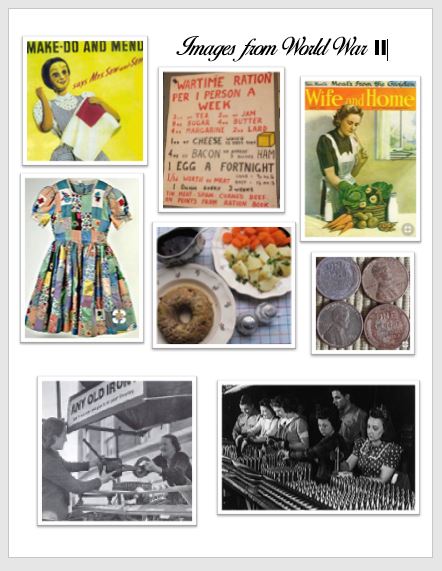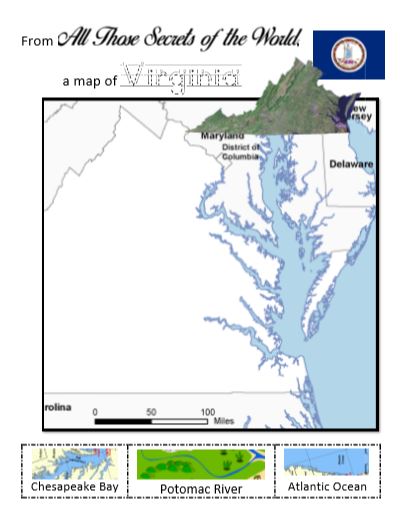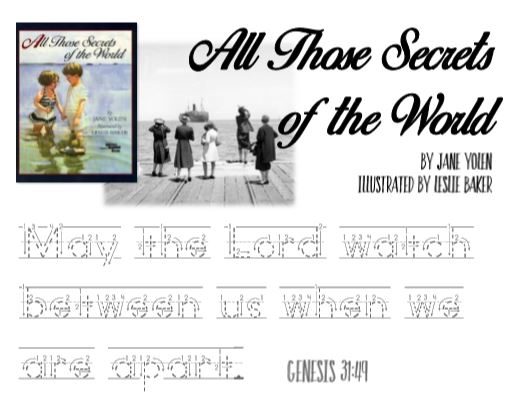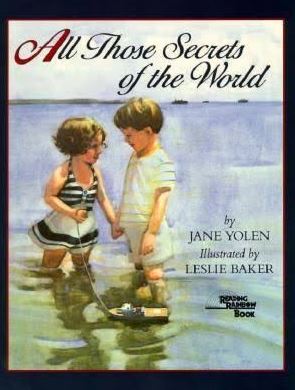If you’ve stumbled here from Pinterest, or some other site … welcome! While each of these books/lessons can stand alone, they are also a part of a year-long series that we have taught at our homeschool co-op. Each lesson builds in part on the one before. Some stories also have similar themes with the books that go before/after them. If you are interested in more information, or to see the complete booklist, check out our main page, More FIAR – Inspired Literature-Based Homeschool Lesson Plans, especially for homeschool and homeschool co-ops. Thanks for looking around, and welcome to the site!
All Those Secrets of the World
by Jane Yolen
Things I Need for Class:
- Map of the World
- Enlarged Map of Virginia
- All Those Secrets of the World Book
- All Those Secrets of the World Handwriting Sheet
- All Those Secrets of the World Geography Sheet
- World War II Cards
If you are following this curriculum to match up with the school year, Veteran’s Day may be right around the corner, or maybe just passed. This book (especially in combinatin with Grandfather’s Journey) is an excellent opportunity to talk about World War II, and the men and woman who served the country. Take the opportunity to tell the kids what Veteran’s Day is, and why our country chooses to remember these warriors who have faught to protect our country and others.
Review from Last Class:
- What book did we read last week? (Grandfather’s Journey)
- Does anyone remember something that happened where the Grandfather couldn’t go back to his home? (Home in Japan was bombed during World War II)
Introduce the Story:
If you are using this in November, go ahead and pull out an actual calendar. In our class, we sung through the months of the year, to the tune of Ten Little Indians. Then, we found our current month (November) and I showed them where Veteran’s day was marked on the calendar and asked if anyone knew what veterans day was? (No one did)
Mention that Veterans Day is a time when our country remembers all the men and women who have served and made sacrifices in the war. Our story today is about a man who went off to war during World War II.
Compare / Contrast Grandfather’s Journey. In Grandfather’s Journey, the Grandpa goes across the Pacific Ocean and back. In today’s story, the Daddy goes across the Atlantic Ocean and back. You don’t have to bring up this point yet (you can save it until you finish the story), but it is a good comparison, and a good way to reinforce the Oceans.
Introduce World War II:
This is a HUGE topic, of course. I recommend skimming this helpful WWII history from Wikipedia:
“In 1942 a rationing system was begun to guarantee minimum amounts of necessities to everyone (especially poor people) and prevent inflation. Tires were the first item to be rationed in January 1942 because supplies of natural rubber were interrupted. Gasoline rationing proved an even better way to allocate scarce rubber. In June 1942 the Combined Food Board was set up to coordinate the worldwide supply of food to the Allies, with special attention to flows from the U.S. and Canada to Britain. By 1943 one needed government issued ration coupons to purchase coffee, sugar, meat, cheese, butter, lard, margarine, canned foods, dried fruits, jam, gasoline, bicycles, fuel oil, clothing, silk or nylon stockings, shoes, and many other items. Some items, like automobiles and home appliances, were no longer made. The rationing system did not apply to used goods like clothes or cars, but they became more expensive since they were not subject to price controls.To get a classification and a book of rationing stamps, one had to appear before a local rationing board. Each person in a household received a ration book, including babies and children. When purchasing gasoline, a driver had to present a gas card along with a ration book and cash. Ration stamps were valid only for a set period to forestall hoarding. All forms of automobile racing were banned, including the Indianapolis 500 which was cancelled from 1942 to 1945. Sightseeing driving was banned.”
Also, for older students, (or just to refresh yourself), this is a good overview of what happened during World War II. It may be a little too much for a younger student though, and I chose not to show it in our 5-7 year old class. But the quick refresher was helpful to know how to summarize WWII to the kiddos
For our class, I shared:
- World War II was a yucky, messy war. Many people died. It’s called a World War because almost the whole world was involved
- German, under an evil man named Hitler, began to take over Europe. He wanted to steal other countries. And he wanted to kill all the Jews. He joined up with other countries in what was called the Axis powers.
- Eventually, The United States was Bombed at a Place called Pearl Harbor.
- The United States and several other countries (Russies and Great Britain) said – this CAN’T KEEP HAPPENING and they finally joined the war.
- Eventually, the bad guys were defeated. But during the War time, everyone made sacrifices. Dad’s went off to war, Mom’s went off to work. Food was rationed. Cars stopped being made. New clothes or parties were a rarity. The world was at war, and everyone paid the price and gave something to help.
To share before or after the story:
 |
| Click here to print Images from World War 2 |
I gathered these images from across the internet. They are not my images, but have been gathered together for educational use. I cut out the pictures and gave each student one picture. We then went around the room, they held up their picture, and we talked about it, one by one.
- Picture 1: Make do and Mend, Mrs. Sew and Sew – fabric was rare, new fabric hard to find and afford. People were encouraged to sew and sew again. Today if we rip clothes or get a stain on it, we quickly throw it away. But then, most everyone knew how to sew and repaired instead of replacing their clothes
- Picture 2: Ration List – Supplies were limited and rationed. Everyone got a ration book which allowed them a small amount of bread, sugar, butter, etc. You waited in lines to get these items. You couldn’t just go to the store and pick up whatever you wanted. Sweets were a rarity because of so little sugar or butter. People began to eat plain meals, especially from their home grown Victory Gardens.
- Picture 3: Victory Garden’s were encouraged to help with the war effort. Plant your own food to eat and share.
- Picture 4: A party dress, created like a quilt from left over materials because her mother couldn’t afford (or find) the needed fabric. New dresses were a rarity because no one could work in the factories to produce clothing
- Picture 5: A simple meal from your garden, with just a bit of canned meat. A typical WWII era family meal. You ate what you were given with thankfulness.
- Picture 6: Coins. Pennies were coated with Zinc instead of Copper, because copper was needed for war efforts.
- Picture 7: Metals were scarce. Any old iron, copper, etc was asked to be donated to help with guns, munitions, and other war parts.
- Picture 8: A bullet factory. Young girls were asked to come work making bullets in 8 hour shifts. They would share houses near the factory, 3 girls to a bed – and each take an 8 hours shift sleeping in the bed after their shift in the bullet factory.
Read the Story:
Some questions to cover as you are reading through:
- Why was the Mommy crying? (2 years a long time, doesn’t know if he’ll come back)
- Two years away – what would have been different about 2 years then vs. two years now? (no computers, phones. Only occasional letters)
- Why do things look so small further away (you can do a quick example of pinching your fingers together to hold a kid who is sitting aross the room. Is __child’s name__ this big? Of course not. All the kids thought this was funny.
- We paused to quickly mention … should she have obeyed her grandparents? (though I didn’t dwell much on this, because I didn’t want to take away from the story)
- How come Stevie doesn’t recognize his dad? (teeny tiny baby – do you remember things from when you were just born?)
Virginia Geography:
Since we are located in Virginia, we especially took the time to talk about Virginia. The famous rivers (the James, York River, the Rappohanock, and the Potomac River.
- We discussed the differences between a BAY, a RIVER, and an OCEAN.
- They located the three on the map below, and cut out the labels and glued them on.
- They traced the word, “Virginia”
- Some kids (the more advanced writers) labeled the names of the Rivers.
We found our city on the map, again emphasizing it is located on a river – something we discussed the significance of when studing The Little Red Lighthouse
 |
| Click here for printable version |
Handwriting Sheet:
Finally, we finished with our handwriting … just remember to start your letters at the top.
The verse was a reminder that the Lord watches between us and our families when we are apart.
 |
| Click here for printable version |
That’s it for this week! To see what we’ve done so far in our Homeschool Co-op’s Literature Series this year, click here. Each lesson builds on the one before and seeks to cover basic geography within the book, historical contexts, a handwriting sheet and a language arts lesson, as it applies to the book.
Or, you can check out the complete Learning the ABC’s through Literature Series, which is a similar series that we did with this same group of kiddos a year earlier. Both of these series of books have been inspired by the Five in a Row curriculum, with many of the books being the same. The ideas, implementation of it for a co-op, and printables are all my own, unless otherwise indicated. Thanks for stopping by to check it out!





